- The Earth's oceans seamlessly blend into each other, making it challenging to distinctly separate them from one another.
- Geographers have categorised the oceanic expanse into five primary oceans: the Pacific, the Atlantic, the Indian, Southern, and the Arctic.
- These vast oceans encompass numerous seas, bays, gulfs, and various inlets.
- A substantial part of the ocean floor lies at considerable depths, typically ranging between 3 to 6 kilometres below sea level.
- The ocean floors are notably rugged, boasting the world's most extensive mountain ranges, deepest trenches, and the largest plains.
- These distinct features, akin to those found on the continents, are shaped by a combination of tectonic, volcanic, and depositional processes.
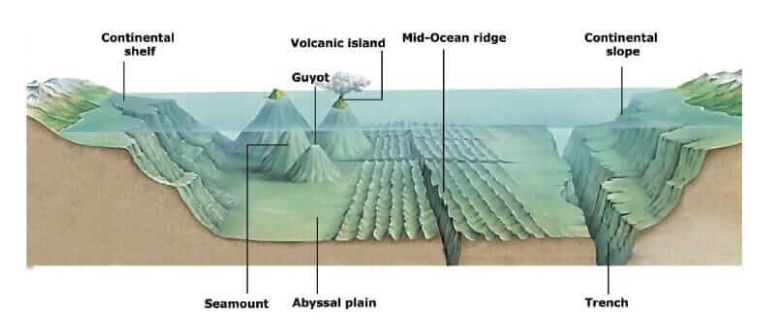
Underneath the ocean waters lie a diverse array of landscapes resembling those on land. Much like the land, the ocean floor exhibits mountains, basins, plateaus, ridges, canyons, and trenches. These landforms beneath the ocean water are collectively referred to as submarine relief.
The ocean basins are typically categorised into four primary subdivisions:
(a) Continental shelf
(b) Continental slope
(c) Abyssal plains
(d) The ocean deeps
CONTINENTAL SHELF
The demarcation between continents and oceans is not sharply defined; in reality, the transition from continent to ocean isn't abrupt.
- Continents gradually slope towards the sea until reaching a point where the descent becomes notably steep.
- This gently sloping, submerged extension of the continent is referred to as the continental shelf.
- The depth of the water over the continental shelf ranges from about 120 to 370 metres.
- The width of the continental shelf displays significant variability, spanning from just a few kilometres to over 100 kilometres.
- Notably, this variation is observable even in the context of the Indian peninsula.
- For instance, the continental shelf off the eastern coast of India is notably broader compared to the shelf off the western coast. Such differences in shelf width are observed worldwide.
- For instance, off the coast of West Europe, the shelf extends up to 320 kilometres from the Cape of Land’s End.
- Conversely, off the coast of Florida, the shelf measures 240 kilometres wide.
- However, in some continents, the shelves are much narrower or even absent, particularly where fold mountains run parallel or close to the coast, such as along the eastern Pacific Ocean.
The majority of continental shelves are believed to represent land that has been submerged due to rising sea levels.
There are various theories regarding their formation.
- Some suggest they formed due to the erosional action of waves or due to the extension of land through the deposition of river-borne material on the offshore terraces.
- In regions that were once covered by ice sheets, glacial deposits may have contributed to the development of these shelves.
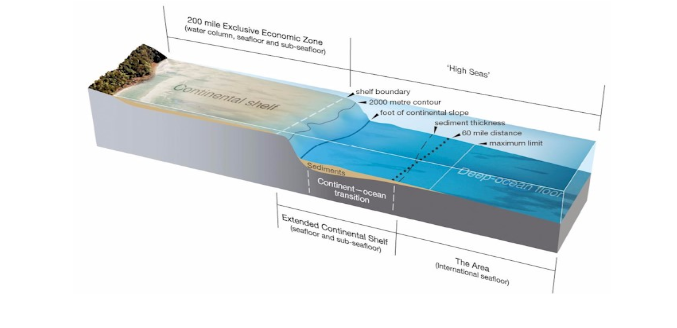
IMPORTANCE OF CONTINENTAL SHELF
- Continental shelves hold significant importance for human activities and ecosystems.
- Their shallow waters allow sunlight to penetrate, promoting the growth of microscopic plants and animals known as plankton.
- These planktons form the basis of the food chain for various marine organisms, especially fish.
- These shelves are a vital source of various resources.
- They provide a rich fishing ground, are a source of minerals such as sand and gravel, and hold immense reserves of petroleum and natural gas.
- For instance, many oil and gas reservoirs are situated beneath the continental shelf. Notable examples include the Bombay High and the discovery of petroleum in the Godavari basin, both of which are outcomes of onshore drilling on the continental shelf.
- Moreover, continental shelves host coral reefs and other deposits like lipo clastic materials, further adding to their ecological and commercial significance.
SUBMARINE CANYON

- The continental shelf boasts an intriguing characteristic—submarine canyons—that extend to the continental slope.
- These canyons resemble steep-sided valleys similar to those found on land, such as gorges.
- One notable example is the Godavari Canyon located in front of the Godavari river mouth, which plunges to a depth of 502 metres.
- Submarine canyons are formed due to various reasons, and one of the significant causes is underwater landslides.
- Sediments accumulated on the continental shelves can get dislodged by natural events like storms or earthquakes.
- The force of these moving sediments erodes the slopes as they descend, thereby creating submarine canyons.
- Traditionally, the territorial waters of nations extend over the continental shelf that is contiguous to their land.
CONTINENTAL SLOPE
- The continental slope, positioned seaward from the continental shelf and stretching to the deep sea floor of the abyssal plain, is a continuous sloping section of the continental margin.
- This geographical feature is characterised by gradients generally around 2.5 degrees and extends to a depth range of approximately 180 to 3,600 metres.
- In specific areas, like off the coast of the Philippines, the continental slope plunges to considerable depths.
- Owing to their steepness and the increasing distance from the shore, continental slopes often have minimal sediment deposits compared to the continental shelf.
- Consequently, the marine life present on the slope is much scarcer than on the shelf.
- At the base of the continental slope, there is a layer of sediment deposits, forming what's known as the continental rise. This belt of sedimentary accumulations can vary widely in width, ranging from very narrow in some regions to extending up to 600 kilometres in others.
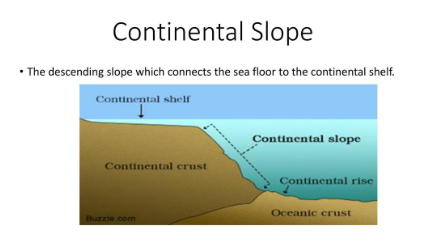
ABYSSAL PLAIN
Abyssal plains constitute the notably level and uniform areas of the deep ocean floor, often regarded as some of the flattest expanses on Earth.
They cover a substantial portion of the ocean floor, typically found at depths between 3,000 metres and 6,000 metres.
- Initially considered to be relatively featureless, modern technology has revealed that abyssal plains are more diverse and complex than previously thought.
- They exhibit varied landscapes with extensive submarine plateaus, hills, guyots, seamounts, and other formations.
- The floor of the abyssal plain is predominantly covered by sediments.
- The regions closer to the continents are primarily layered with sediments carried from the land.
- However, areas with prolific life support tend to accumulate a thicker layer of sediments, largely composed of the remains of marine organisms.
- These sediment accumulations are often referred to as "ooze."
- Conversely, certain open seas with less abundant life support fail to generate enough organic material for ooze formation.
- These areas are coated with a type of sediment called red clay, which comprises volcanic residues or minute particles transported by wind and rivers.
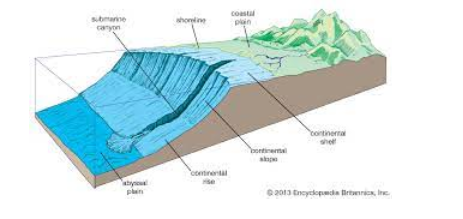
SUBMARINE RIDGE
- Beneath the ocean waters, there exist substantial mountain systems analogous to the lofty ranges found on continents.
- These undersea mountain ranges are referred to as submarine ridges and are typically linear belts situated near the centre of oceans, commonly known as mid-oceanic ridges.
- The mid-oceanic ridges form a global, interconnected system that extends from one ocean to another and is often marked by faults.
- These ridges are frequently prone to seismic activity, leading to frequent earthquakes. Additionally, the volcanic activity in these ridges results in the creation of various relief features.
- Among the mid-oceanic ridges, the Mid-Atlantic Ridge is the most expensive continuous submerged mountain ridge, stretching from the northern to southern regions of the Atlantic Ocean in an S-shaped pattern.
- Some peaks along this ridge rise above the water's surface, forming islands, many of which have volcanic origins. Notable submarine ridges include the East Pacific Ridge and Carlsberg Ridge.
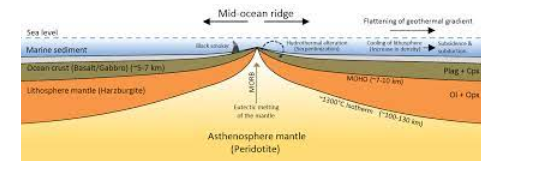
SEAMOUNTS AND GUYOTS
- Distributed across the entire ocean floor, there are numerous submerged volcanoes with pointed peaks known as seamounts.
- At times, these rise above the water's surface as isolated islands.
- For instance, the Hawaii and Tahiti Islands are the visible summits of such underwater volcanoes.
- When a volcano emerges above the ocean floor but its peak has been flattened due to erosion and is submerged under water, it is called a guyot.
- These formations represent volcanic mountains that have subsided and been eroded over time.

THE OCEAN DEEPS
- The ocean depths are the most profound sections of the ocean floor, manifesting as long, narrow, steep-sided depressions with flat floors.
- Often referred to as submarine trenches, these formations aren't consistently situated in the middle of ocean basins but are frequently positioned near or parallel to continental regions, especially in the vicinity of fold mountains.
- These trenches are commonly found adjacent to areas of intense volcanic and seismic activity.
- They are crucial sources of great earthquakes and tsunamis. Submarine trenches occur in all major oceans, with the Pacific Ocean hosting the largest number of these formations.
- Among these oceanic chasms, the Mariana Trench in the Pacific Ocean stands as the deepest known part of the world's oceans.
- Its extreme depth is such that if the highest mountain on Earth, Mount Everest, were placed within it, there would still be several kilometres of water above Everest's summit.
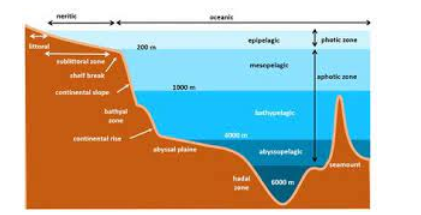
FAQs regarding OCEANIC RELIEF FEATURES
1. What are the primary oceanic divisions, and how do they compare to the continents?
Ans. The Earth's oceans are divided into five major bodies of water: the Pacific, Atlantic, Indian, Southern, and Arctic Oceans. Unlike the continents, the oceans blend seamlessly into each other, making their separation challenging.
2. What features characterise the ocean floor?
Ans. The ocean floor boasts an array of landscapes similar to those on land. It hosts mountains, basins, plateaus, ridges, canyons, and trenches. These features beneath the ocean water are collectively referred to as submarine relief.
3. What are the four major subdivisions of the ocean basins?
Ans. The primary subdivisions of ocean basins are the continental shelf, continental slope, abyssal plains, and the ocean deeps.
4. How are the continental shelf and its variations explained?
Ans. The continental shelf refers to the gently sloping, submerged extension of the continent. It extends from the coast and can vary significantly in width and depth. Variations are seen worldwide and often attributed to geological factors and glacial deposits.
5. Why are continental shelves important?
Ans. Continental shelves foster marine life by enabling sunlight penetration and supporting the growth of plankton, forming the base of the food chain. They are rich fishing grounds, host various resources like petroleum and minerals, and support unique ecosystems.
6. What's the significance of submarine canyons?
Ans. Submarine canyons are steep-sided valleys akin to gorges found on land. Their formation is often linked to underwater landslides dislodging sediments, which erode the slopes and create these distinct formations.
7. What characterises the continental slope and continental rise?
Ans. The continental slope, sloping seaward from the shelf to the deep sea floor, has steeper gradients and minimal sediment deposits. The continental rise forms a belt of sedimentary accumulations at the base of the slope.
8. What are abyssal plains, and how varied are they?
Ans. Abyssal plains represent the flat and level areas of the deep ocean floor. Initially thought to be featureless, modern technology has revealed their diversity, with extensive plateaus, hills, guyots, and seamounts. Sediments cover the floor, formed from various sources.
9. What defines a submarine ridge, and are there prominent examples?
Ans. Submarine ridges are linear belts of undersea mountain ranges known as mid-oceanic ridges, interconnected across the oceans. They often experience seismic activity and volcanic eruptions. Notable ridges include the Mid-Atlantic Ridge, East Pacific Ridge, and Carlsberg Ridge.
10. What are seamounts and guyots, and what role do they play?
Ans. Seamounts are submerged volcanoes with sharp peaks, some of which rise above the sea as isolated islands. Guyots are flattened, submerged volcanic mountains that have emerged but been eroded over time.
11. What are the ocean deeps or submarine trenches, and why are they significant?
Ans. Ocean deeps are the deepest parts of the ocean floor, featuring steep-sided depressions. Submarine trenches, often near continental regions, are sources of intense seismic and volcanic activity. The Mariana Trench is the deepest known part of the world's oceans.

